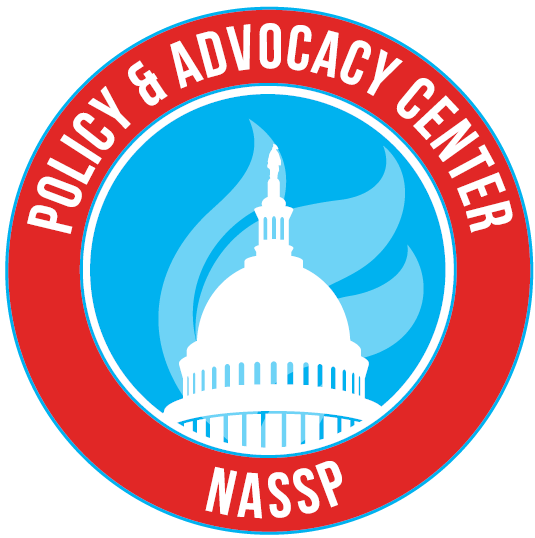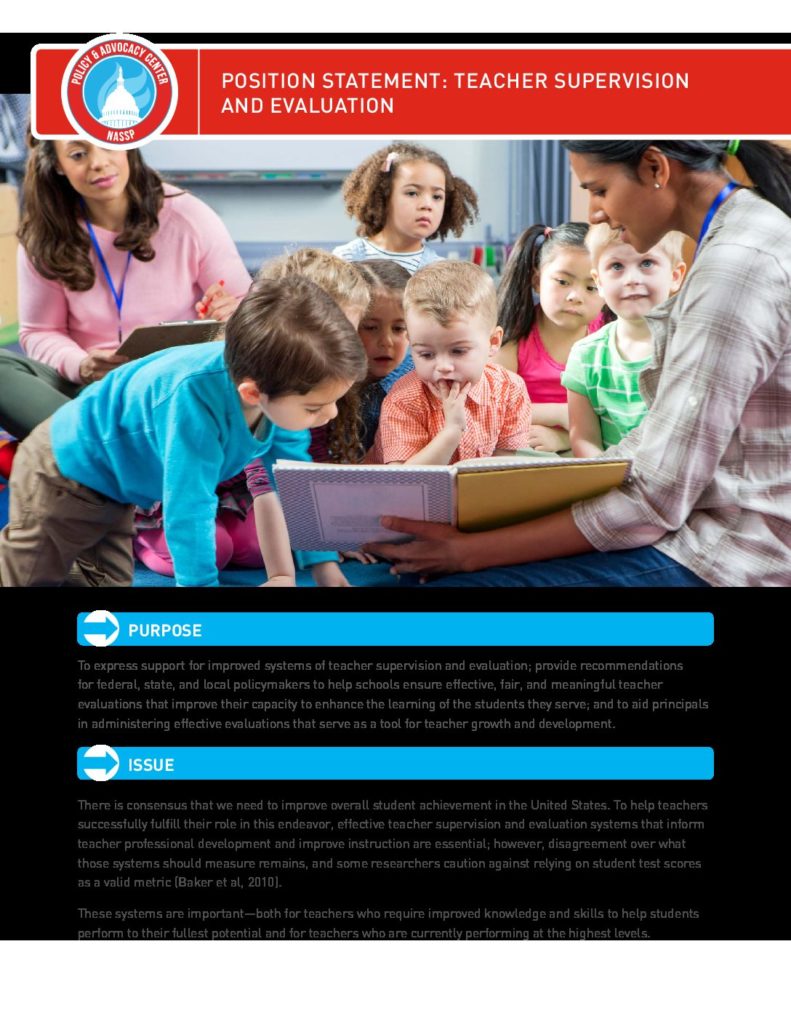To express support for improved systems of teacher supervision and evaluation; provide recommendations for federal, state, and local policymakers to help schools ensure effective, fair, and meaningful teacher evaluations that improve their capacity to enhance the learning of the students they serve; and to aid principals in administering effective evaluations that serve as a tool for teacher growth and development.

There is consensus that we need to improve overall student achievement in the United States. To help teachers successfully fulfill their role in this endeavor, effective teacher supervision and evaluation systems that inform teacher professional development and improve instruction are essential; however, disagreement over what those systems should measure remains, and some researchers caution against relying on student test scores as a valid metric (Baker et al, 2010).
These systems are important—both for teachers who require improved knowledge and skills to help students perform to their fullest potential and for teachers who are currently performing at the highest levels. Regardless of the current political context, effective teacher performance appraisal systems are a core element in the effort to improve student learning and necessary to inform compensation systems based on teacher performance.
Currently, teacher supervision and evaluation systems vary greatly across the nation, particularly for tenured teachers, but the results of these diverse systems have been historically very similar. The 2009 publication The Widget Effect (Weisberg, Sexton, Mulhern, & Keeling, 2009), a study of teacher evaluation practices in 12 diverse districts in four states, found that over 99 percent of tenured teachers in districts using a satisfactory or unsatisfactory rating system earned a positive rating. Among districts with more than two rating options, 94 percent of the teachers still earned one of the top two ratings, and less than 1 percent were rated unsatisfactory. This seminal report made it clear that teacher evaluations at the time were largely a rubber stamp with little insight into the actual effectiveness of their performance.
The influential publication of The Widget Effect—coupled with new federal incentives and requirements for states to revamp and improve teacher evaluation, including the enactment of federal “Race to the Top” grants in 2009 which encouraged states and districts to revamp outdated evaluation systems and the ESEA flexibility waiver process enacted by the Obama administration in 2012—led to a national resurgence of state action on evaluation. Almost every state has designed and adopted new teacher evaluation systems in the last decade as a result. As of 2015, 27 states required annual evaluations for all teachers, compared to just 15 states in 2009 (Doherty & Jacobs 2015).
Incentive for states to continue to assess, improve, and implement new evaluation systems dropped off considerably, however, when Congress passed the Every Student Succeeds Act (ESSA) in 2015. While ESSA does require states to have a definition of what constitutes teacher ineffectiveness, states are not required to implement evaluation systems, and it prohibits the secretary of education from requiring evaluations or establishing any parameters around how states define teacher effectiveness (Pennington & Mead 2016). Some states have begun to roll back teacher evaluation requirements in recent years, as well, specifically around student growth measures being used in evaluations (Loewus 2017).
As policymakers continue to revamp teacher evaluation requirements, it will be critical to ensure adequate levels of support are provided in the correct areas in addition to ensuring that the most appropriate indicators of success are being measured. For example, a commonly stated purpose of teacher evaluations is targeted professional development to improve teacher effectiveness; however, a presentation from education policy expert Linda Darling-Hammond (2010), noted that well under half of all teachers receive continuous professional development, mentoring or coaching, or engage in peer observation as a result of evaluation. Ninety percent of teachers participate in one- or two-day workshops or conferences to fulfill professional development requirements in lieu of participation in sustained professional development that has been shown to deliver significant returns in student achievement, such as lesson study, peer observation and coaching, and ongoing learning opportunities embedded in practice.
Guiding Principles
- Building Ranks™: A Comprehensive Framework for Effective School Leaders provides a framework for effective school leaders to improve the performance of each student by building culture and leading learning.
- The 2015 Professional Standards for Educational Leaders state that effective leaders develop the professional capacity and practice of school personnel to promote each student’s academic success and well-being.
- NASSP recognizes that school administrators are the instructional leaders of the school and as such should be experts in instruction and in assessing and enhancing the instructional performance of their staff, as evidenced by student performance.
- NASSP believes that teaching is a complex craft and that evaluation of effective teaching should be based on close examination of a variety of variables through quantitative and qualitative data, take into account the context in which a teacher works, and not be limited to students’ performance on standardized tests.
- NASSP recognizes that although states or districts currently bear the responsibility for creating the structure and format of teacher performance appraisals and determining the multiple measures used in assessing the teacher’s performance, principals carry out the process of daily supervision and are responsible for the development of teachers’ capacity to perform effectively.
Recommendations
Recommendations for Federal Policymakers
- In collaboration with all education stakeholders, develop a teacher evaluation and support system that includes the following components:
- Feedback and reflective practice
- Multiple measures of classroom practice, student learning, and other evidence related to the teacher’s contribution to schoolwide improvement
- High-quality training, credentialing, and ongoing professional development for principals to fully understand the teacher evaluation rubric and to coach and mentor teachers to improve their practice
- The U.S. Department of Education should support ongoing research to establish the validity and reliability of comprehensive teacher evaluation programs, further examine the efficacy of value-added models of teacher evaluation, and support adequate training and professional development of evaluators to ensure fidelity of implementation of evaluation models found to be effective in improving teaching and learning.
Recommendations for State and Local Policymakers and School Districts
- States and districts should develop frameworks for teacher performance appraisal that are based on research-supported best practices, consistent in application, fair to teachers and evaluators, and valid and reliable measures of teacher performance.
- States and districts should include multiple measures of performance, including but not limited to: input measures such as evidence of a teacher’s knowledge of subject matter; skill in planning, delivering, monitoring, and assessing students’ learning; skill in developing and maintaining positive relationships with students, parents, and colleagues; knowledge and skill in pedagogical methods to meet the needs of students with an array of learning styles and needs; and commitment to students’ learning to their utmost potential. Examples of outcome data that are also appropriate and necessary to assess teacher effectiveness are: students’ individual growth and progress as measured on valid and reliable standardized instruments, teacher-made tests that align with the curriculum, student performance demonstrations in a variety of media, and portfolios of student work.
- States and districts should establish systems in which all stakeholders collaborate in the development of teacher performance appraisal processes and instruments to create ownership and commitment to effective performance appraisal focused on improved student learning. That should include creating a committee comprising of teachers, state and local teachers union or collective bargaining representatives, principals, assistant principals, and district administrators to select or develop validated and reliable evaluation instruments that its constituent districts and schools can use.
- States and districts should establish performance appraisal frameworks that recognize improved teaching as the collective responsibility of principals, assistant principals, teacher leaders, teachers, and district office personnel, utilizing subject-area and grade-level specialists, where available, to enrich the appraisals and more effectively guide subsequent professional development.
- States and districts should take into consideration the demands placed on the principal and other personnel who conduct the evaluations because effective teacher performance appraisal must to be thorough and accurate—thus, time and labor intensive.
- States and districts should create performance appraisal systems with differentiated approaches to evaluation that are based on teachers’ knowledge, skills, and experience. For example, beginning teachers may require more intensive supervision in the evaluation process.
- States and districts should provide comprehensive training to personnel who contribute to an evaluation to ensure effective and fair evaluations.
- States and districts should use evaluation results to develop the professional learning opportunities for teachers. NASSP recommends in its Building Ranks™: A Comprehensive Framework for Effective School Leaders that school leaders develop an individualized professional growth plan that is aligned with the school’s vision, mission, and goals.
- States and districts should require that principal licensure programs include evidence of knowledge of methods of teacher evaluation and evidence of proficiency in supervision of instruction as core competencies.
Resources
Baker, E., Barton, P., Darling-Hammond, L., Haertel, E., Ladd, H., Linn, R., … Shepard, L. (2010). Problems with the use of student test scores to evaluate teachers. Economic Policy Institute Briefing Paper #278. Retrieved from the Economic Policy Institute Web site.
Bill & Melinda Gates Foundation MET Project (2013). Ensuring fair and reliable measures of effective teaching. Retrieved from https://secure.edweek.org/media/17teach-met1.pdf
Coalition for Teaching Quality (2016). Strengthening pathways of professional learning and growth for teachers and principals. Retrieved from http://coalitionforteachingquality.org/images/upload/201606_Growth.pdf
Darling-Hammond, L. (2010, August). Developing powerful teaching: What it will really take to leave no child behind. Power Point presented at the Education Commission of the States National Forum on Education Policy in Portland, OR. District of Columbia Public Schools.
Doherty, K. & Jacobs, S. (2015). State of the states 2015: Evaluating teaching, leading, and learning. National Council on Teacher Quality. Retrieved from https://www.nctq.org/dmsView/StateofStates2015
Education Commission of the States (2018). Policy snapshot: Teacher evaluations. Retrieved from https://www.ecs.org/wp-content/uploads/Teacher_Evaluations.pdf
Kraft, M.A. & Gilmour, A.F. (2017). Revisiting the Widget effect: Teacher evaluation reforms and the distribution of teacher effectiveness. Educational Researcher, 46(5), 234-249. Retrieved from Harvard University website.
Loewus, L. (2017). Are states changing course on teacher evaluation? Test score growth plays lesser role in six states. Retrieved from Education Week website.
National Association of Secondary School Principals (2018). Building Ranks™: A comprehensive framework for effective school leaders. Retrieved from https://www.nassp.org/professional-learning/building-ranks-for-school-leaders/
National Council on Teacher Quality (2015). Making a difference: Six places where teacher evaluation systems are getting results. Retrieved from https://www.nctq.org/publications/Making-a-Difference New America (2016). Beyond ratings: Re-envisioning state teacher evaluation systems as tools for professional growth. Retrieved from https://static.newamerica.org/attachments/12740-beyond-ratings-2/NA_BeyondRatingsPaper.87353c50fc4a4411881b576a5053536e.pdf
Pennington, C. and Mead, S. (2016). For good measure? Teacher evaluation policy in the ESSA era. Bellwether Education Partners. Retrieved from https://bellwethereducation.org/sites/default/files/Bellwether_ForGoodMeasure-GPLH_Final1216%20(1).pdf
Reid, D. B. (2017). U.S. principals’ interpretation and implementation of teacher evaluation policies. The Qualitative Report, 22(5), 1457-1470. Retrieved from https://nsuworks.nova.edu/tqr/vol22/iss5/19
Sawchuk, S. (2015). Teacher evaluation: An issue overview. Education Week. Retrieved from https://www.edweek.org/ew/section/multimedia/teacher-performance-evaluation-issue-overview.html?content-explainerteacheval
Southern Regional Education Board (2016). State actions to advance teacher evaluations. Retrieved from https://www.sreb.org/sites/main/files/file-attachments/160210_stateactionstoadvanceteachereval.pdf Weisberg, D., Sexton, S., Mulhern, J., & Keeling, D. (2009). The widget effect: Our national failure to acknowledge and act on differences in teacher effectiveness. Retrieved from https://tntp.org/publications/view/the-widget-effect-failure-to-act-on-differences-in-teacher-effectiveness

